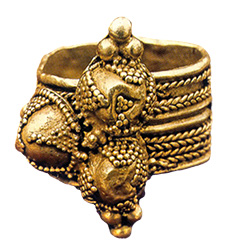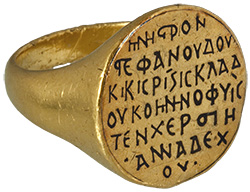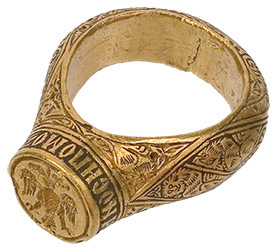Treasuries
SERBIAN ARCHAEOLOGY IN 150 STORIES: GOLDEN RINGS STEFAN PRVOVENČANI, PRINCE RADOSLAV AND QUEEN THEODORA
Three Valuables of the Nemanjić Serbia
A little has been preserved of the royal jewelry of the Nemanjić Dynasty and many questions have remained. It makes these three exceptional artifacts all the more valuable. The first one was discovered suddenly in 1935, in the second trial, in reliquary of the Crowned King in Studenica. The second was discovered by Medaković, a member of Academy of Sciences and Arts, in 1960’s in an antique shop in Munich. The third had an unusual journey from the foundations of Banjska to the showcase of the National Museum
By: Vojislav Filipović
Illustrations: The National Museum in Belgrade
 Golden rings which can be with a high degree of probability linked to the members of the Nemanjić dynasty are extremely rare in our country. Even in a wider meaning of royal or later imperial jewelry of the Nemanjić dynasty, golden rings of Stefan Prvovenčani, Prince Radoslav and Queen Theodora represent, for now, the only preserved pieces of jewelry that belonged to Serbian medieval rulers or their immediate family members. Golden rings which can be with a high degree of probability linked to the members of the Nemanjić dynasty are extremely rare in our country. Even in a wider meaning of royal or later imperial jewelry of the Nemanjić dynasty, golden rings of Stefan Prvovenčani, Prince Radoslav and Queen Theodora represent, for now, the only preserved pieces of jewelry that belonged to Serbian medieval rulers or their immediate family members.
Although one might think given that the Serbian kings may have been poor or modest, Byzantine statesman and writer Theodore Metochites, who was on two occasions at the court of King Milutin, describes: ”Even the king himself was very nicely decorated with jewels. Around his body he had more jewels and pearls, as many as could fit, and he shimmered in gold.” From this description, other historical accounts and artistic presentations, it is clear that the Serbian kings and their families use the diverse and elegant jewelry which, in addition to rings, also included earrings, diadems, bracelets, belts, buckles and buttons, and we could say that the royal jewelry of the Nemanjić dynasty has remained a great mystery until today. Also, for each of these three rings there is a different story about the circumstances in which it was found.
SIGNS OF POWER AND NOBILITY
 The ring of the great prefect, the later king Stefan Prvovenčani, was actually discovered only in the ”second attempt”. During the first opening of the reliquary, in 1813, the ring was not found, and only in 1935 the abbot of Studenica Monastery said that in ”the reliquary there is a royal ring on a chain, received from Saint Sava”. The ring was decorated with four conical protrusions (only three were preserved) and filigree threads. The appearance of the ring, as well as the fact that the king received it from his brother, Saint Sava, indicate that it was jewelry work several decades older than the time when Stefan was appointed prefect, and it is assumed that it could be a part of the inherited family jewelry. The ring of King Stefan is now in the treasury of Studenica Monastery. The ring of the great prefect, the later king Stefan Prvovenčani, was actually discovered only in the ”second attempt”. During the first opening of the reliquary, in 1813, the ring was not found, and only in 1935 the abbot of Studenica Monastery said that in ”the reliquary there is a royal ring on a chain, received from Saint Sava”. The ring was decorated with four conical protrusions (only three were preserved) and filigree threads. The appearance of the ring, as well as the fact that the king received it from his brother, Saint Sava, indicate that it was jewelry work several decades older than the time when Stefan was appointed prefect, and it is assumed that it could be a part of the inherited family jewelry. The ring of King Stefan is now in the treasury of Studenica Monastery.
The second artifact, engagement ring of Prince Radoslav, is a testimony of the splendid sovereign equipment and jewelry, but also of the routes of Serbian medieval diplomacy and its links with the Byzantine court. The ring has a massive head with an inscription in Greek in seven rows, in verses: ”This is the engagement ring of Stefan, an offspring of Duka, and thus, Anne from the Komnin family, receive him in your embrace.” The verses were composed by the metropolitan and statesman Jovan Apokavk, who strongly advocated this marriage. The ring was probably made in Thessaloniki, and the engagement ceremony took place in 1219, or early 1220. The text was written in Greek because the prince wanted to emphasize his origin, since on his mother's side he was a grandson of Byzantine Emperor Alexius III and was educated in Byzantine spirit. Radoslav welcomed his bride at his father’s court in Pauni near Uroševac, where the wedding ceremony also took place. The ring was obtained thanks to DejanMedaković, a member of Academy of Sciences and Arts, who noticed it in the 1960’s at an antique store in Munich. He notified the National Museum in Belgrade about this, which purchased it for what was then 5,000 deutsche marks.
IN TEMPLE FOUNDATIONS
 The ring of Queen Theodora dates back to the first decades of the 14th century and is a masterpiece of Serbian goldsmith. It belonged to Queen Theodora, wife of Stefan Dečanski and mother of Emperor Dušan, who died in October 1322, and was then buried in Banjska Monastery, endowment of Stefan’s father, King Milutin. The circumstances in which the ring was found are a series of curious events, fortunately with a favorable outcome. Namely, in 1915, during the war, when Serbian army was withdrawing toward Albania, several days long excavations began in Banjska Monastery, apparently under supervision of regent Aleksandar Karađorđević himself. The goal was probably to find the legendary treasure of King Milutin in the monastery foundations. On this occasion, a female grave was found in the narthex, probably Queen Theodora’s, whose bones, after two rings had been taken off from her hand, were carefully collected and reburied in the altar in the presence of a priest. The ring of Queen Theodora dates back to the first decades of the 14th century and is a masterpiece of Serbian goldsmith. It belonged to Queen Theodora, wife of Stefan Dečanski and mother of Emperor Dušan, who died in October 1322, and was then buried in Banjska Monastery, endowment of Stefan’s father, King Milutin. The circumstances in which the ring was found are a series of curious events, fortunately with a favorable outcome. Namely, in 1915, during the war, when Serbian army was withdrawing toward Albania, several days long excavations began in Banjska Monastery, apparently under supervision of regent Aleksandar Karađorđević himself. The goal was probably to find the legendary treasure of King Milutin in the monastery foundations. On this occasion, a female grave was found in the narthex, probably Queen Theodora’s, whose bones, after two rings had been taken off from her hand, were carefully collected and reburied in the altar in the presence of a priest.
The second, silver ring with embedded antique gemstone, ended up in the collection of the family of collector Ljuba Nedeljković. The ring itself was cast in one piece and was lavishly decorated over the entire surface with painting and carving. On the top there is a carving of a two-headed eagle with spread wings, and around the neck of the ring there is an inscription ”+May God help to those who wear it”. The link is lavishly decorated with floral ornaments and images of lions and griffon.
***
Journey to the Museum
The ring of Queen Theodora, discovered in Banjska in 1915, ended up in the collection of Regent Aleksandar, who wore it on his hand for a while, and then as a pendant on a watch chain. After the war, under the pressure of superstition, the king gave it to his friend, lawyer Blagoje Brlovac, but even he was afraid of it, and in 1926 he secretly handed it to the National Museum in Belgrade.
***
Two-headed Eagle
The second ring discovered in Banjska, the silver one, is also important for its heraldic presentation of two-headed eagle as the coat-of-arms of the Nemanjić dynasty, since before that he had appeared only on frescoes as a motif on royal garments.
|
